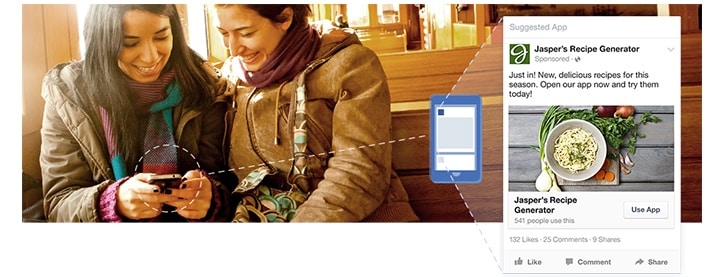The Secret to Great Facebook Advertising
by Manny Lopez • August 5, 2015
Facebook has become a part of our everyday life. We have grown accustomed to updating our status, reporting on our current location and uploading wonderful photos of what we are eating.
With 1.44 billion active users and counting, Facebook advertising presents a huge opportunity for marketers to market their products or services. However, marketing to a worldwide audience of 1.44 billion people is a guaranteed way to waste money, so it’s critical to know how to target your ads to the right group of users.
The question is, what’s the best way to identify and target your ideal audience? The answer is data.
Data is the key to understanding who and how a user interacts with your Facebook page. Luckily, Facebook offers a great service called Facebook Page Insights, which allows you to breakdown your page’s data by demographics and age, post shares and re-shares, mentions, referrals, and much more.
So, let’s dig into your page’s analytics and see how you can use that data to empower your advertising—you might be surprised on what you find.

Facebook Analytics
Here are some of the most important metrics you should monitor to ensure that you are targeting the people that are most likely to interact with your ads and convert into a sale.
User Demographics
With Facebook Insight, you can see your audience’s age, sex and location. Armed with this information, it’s simple to set up different Facebook campaigns targeted at different age groups, genders, and regions. This is an effective way to test out different headlines and imagery that might be more appealing to a certain group of people.
Language Targeting
Knowing the primary language that the user speaks can save you from spending money on an audience that can’t understand your ad or website. Additionally, for the multilingual advertisers out there, you can use language targeting to write effective ad copy in a specific language.
Interest Targeting
Knowing a person’s interests is a valuable piece of information that Facebook makes very accessible. Information such as self-selected interests, liked pages, education, job title, joined groups, and downloaded apps allow you to target people with a good chance of being interested in your product or service.

Use Analytics to Design Your Ad
Once you understand your target audience, you can use that knowledge to create ads that resonate with your audience. That, in turn, leads to the clicks and conversions you need.
Generally speaking, there are two primary types of ads you should consider: video and image ads.
Video
So, what type of ads gets the most clicks? Which ads convert better?
While the answer is always audience-specific, the data is in and—according to Facebook—videos get more activity than images or text ads. In fact, over 50% of Facebook’s 628 million daily users watch at least 1 video per day, which adds up to a whopping 1 billion daily video views!
Facebook does a great job of setting video ads up for success with its Autoplay feature. According to Facebook, Autoplay increases the number of people that interact with the videos by 10%. That being said, there’s no sound with Autoplay, so you need to make sure that your video catches a person’s attention in the first 3 seconds without sound.
Images
As great as videos might be, creating a video for every ad isn’t always a practical option. If that’s the case for you, the next best option is to create great image ads.
According to a study done in 2014, images produce more Likes than most other types of posts. This means that people prefer imagery on their timeline and are more likely to click on ads with an image then plain text ads.

Choosing the right image is often times the hardest part of putting together an image based ad. Ideally, the image should be compelling enough that the user can’t help but wonder about the product or service. For example, some companies have found that funny images or smiling women are great for boosting conversion rate.
Images can be great; but, if you are going to use images on your Facebook ad, you do have to follow the 20 percent rule. If you have text on your image, the text cannot take up more than 20% of the image. The rule is simple, but Facebook is a stickler about it. Fortunately, to make your life easier, Facebook offers a simple online tool for determining whether or not your picture meets their requirements.
Retargeting Strategy
Unfortunately, even if you use your data to create the perfect ad and landing page, many of the visitors to your site still won’t convert. What do you do with these people? Retarget, of course!
Retargeting is a very powerful tool that allows you to target new ads to people who have shown interest in your product or service.
Facebook’s multi-product ads is a great retargeting tool that is very similar to Google’s “dynamic ads.”
Multi-product ads tracks visitors to your site using a code snippet that allows you to see where the user fell off in the sales funnel. That way, you can retarget them with ads for the same product or service they thought was interesting the first time around.
Conclusion
While most of us check Facebook on a regular basis, there are a lot of things clamoring for our attention. To stand out in your audience’s feeds, you need to skillfully target your audience and use that targeting to create ads that really resonate with users.
In other words, make ads that people don’t mind sharing. Run a contest! Make it hard for people to pass up your ad. Use what you learn from Facebook Insights, your own Analytics and A/B testing to see what works for your audience and then run with it.
By combining targeting, great ads and rigorous testing, you can set yourself up for Facebook success!
By the way, if you’d like any help setting up a Facebook ad campaign, let me know in the comments.
Now it’s your turn: What have you seen work well on Facebook? How do you target your ads?





